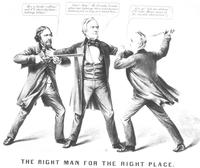1856
| Candidate |
Popular
|
Electoral
|
| James Buchanan Democrat |
1,836,072
|
174
|
| John C. Fremont Republican |
1,342,345
|
114
|
| Millard Fillmore Whig-American |
873,053
|
8
|
James Buchanan, official White House portrait (public domain) |
Stephen A. Douglas' proposal of the Kansas-Nebraska Act, which repealed the provision to prohibit slavery north of the 36o 30' line, added fuel to the sectional dispute, the primary issue of the campaign of 1856. The Democratic Party nominated James Buchanan, an elderly bachelor and Federalist statesman, who had avoided involvement in previous sectional disputes (18A-1066549). John C. Fremont, a colorful former officer and explorer, was nominated by the newly formed anti-slavery party, the Republicans. The American Party and Whigs, sometimes called the Know-Nothings because when asked about their platform they professed to know nothing, nominated Millard Fillmore. Here we see the three candidates represented in a "typical" argument (18B-1066550).
The Republicans' campaign gained momentum after the "Bleeding Kansas" speech of Senator Charles Sumner, who eloquently represented Kansas' position as we see it in this cartoon (18C-1066551). Buchanan's support of the Kansas-Nebraska Act is caricatured in this cartoon (18D-1066552). And again we see Buchanan, this time riding the "monster of slavery," while Fremont orders him back (18E-1066553).
Fremont was sometimes pictured as a young stalwart candidate, in contrast to the doddering senility represented by Buchanan (18F-1066554). But his image was more that of a revolutionary with a rag-tag band of followers (18G-1066555). It was this image that frightened the country into support of a more experienced, sensible Buchanan, who won the election.









